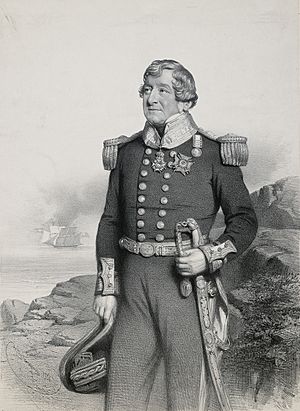William Henry Dillon facts for kids
Quick facts for kids
Admiral
Sir William H. Dillon
KCH
|
|
|---|---|
 |
|
| Born | 8 August 1779 Birmingham, England |
| Died | 9 September 1857 |
| Allegiance | |
| Service/ |
|
| Years of service | 1790 – 1857 |
| Rank | Vice-admiral |
| Commands held |
|
| Battles/wars |
|
Admiral Sir William Henry Dillon (8 August 1779 – 9 September 1857) was a brave British naval officer. He served in the Royal Navy for many years, taking part in important battles and expeditions. He rose through the ranks to become an admiral.
Contents
Sir William Henry Dillon was born in Birmingham, England, in 1779. He joined the navy in May 1790 when he was just 10 years old. His first ship was Defence, where he served as a midshipman.
First Battles and Injuries
Dillon was involved in the famous Glorious First of June battle in 1794. During this fight, he was hit and injured by a piece of wood from the ship. He also took part in Lord Bridport's battle near Ile de Groix in 1795.
In May 1796, he helped capture St. Lucie. He even carried a special flag to take control of Pigeon Island. Later, in 1798, he became an acting-lieutenant on the ship Glenmore. He worked with the army during the Wexford Rebellion in Ireland, where he helped arrest an Irish leader.
Service as a Lieutenant
As a lieutenant on Crescent, Dillon was stationed in Jamaica. He helped capture a Spanish ship called Galgo in the Mona Passage. He then sailed this captured ship back to Jamaica.
Captured by the Enemy
Dillon later served as a senior-lieutenant on the ship Africaine. In 1803, he was sent with a message of peace to a Dutch commander. However, against the rules of war, he was taken prisoner. He was handed over to the French and held captive for four years until September 1807.
Command and Later Achievements
Even while he was a prisoner, William Dillon was promoted to commander on 8 April 1805. After he was released, he took command of a small ship called Childers. This ship had only fourteen cannons and 65 men.
Brave Actions and Awards
On 14 March 1808, off the coast of Norway, Dillon and his crew faced a Danish ship called Lougen. The Danish ship was much larger, with 20 cannons. After a long fight, Dillon managed to drive off the Danish ship. He was badly wounded during this brave action. Because of his courage, he received a special sword worth a lot of money from the Lloyd's Patriotic Fund.
After this, he was promoted to post-captain. He served in many different places, including the Walcheren Expedition, off the coasts of Portugal and Spain, in Newfoundland, China, India, and the Mediterranean. His last command was the large 74-gun ship Russell. He helped the Spanish during his time in the Mediterranean.
Observations in Algiers
In 1812, while on HMS Leopard, Dillon visited Oran and Algiers. He saw many things, including people who were forced to work as slaves. He wrote about how sad it was to see them working under harsh conditions. He also saw a very scary place where people sentenced to death were thrown from walls. He quickly left that area because it was too horrifying.
Later Life and Honors
William Dillon continued to serve with honor. He was promoted to the rank of admiral on 9 November 1846. He received a special award called the Knight Commander of the Royal Guelphic Order in 1835. On 24 June of that year, he was knighted by King William IV at St. James's Palace. This meant he could be called "Sir."
In 1839, he received a good-service pension, which was a payment for his long and excellent service. He became a vice-admiral in 1853 and then a full admiral in 1857. Sir William Henry Dillon passed away on 9 September 1857. He left behind his own written story of his naval career and the many places he had visited.

